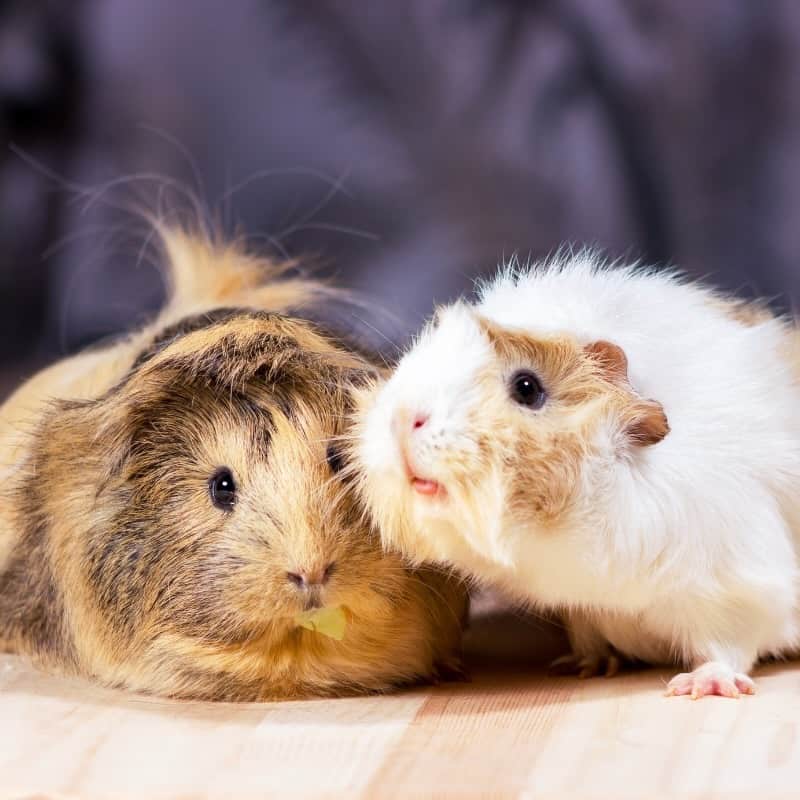FAQ's, Guinea Pigs, How To Do Things
One Guinea Pig or Two: Making the Right Choice
When it comes to caring for guinea pigs, one big question often pops up: is it better to have one guinea pig or two?
In this blog, we’ll explore if guinea pigs can live happily alone and if two pets actually means double the guinea pig care.
We’ll also touch on the financial implications and provide tips for introducing a second guinea pig.
Not sure whether to get one guinea pig or two? Read on for happy healthy guinea pigs!
Understanding Guinea Pig Social Needs
Guinea pigs are social animals, thriving on companionship and interaction. Originating from their instinctual habits in the wilderness, they flourish within a group.
One Guinea Pig or Two?
Owning two guinea pigs rather than one can significantly impact their mental and emotional well-being. These animals communicate through various sounds and movements that are often only fully understood by their own kind.
Without a fellow guinea pig to interact with, they may become lonely or depressed, which can lead to health issues.
The Role of Human Interaction
Guinea pigs require daily interaction. While its valuable for humans to spend time with their pets, it cannot entirely replace the need for another guinea pig pal. It’s important for them to have access to same-species company.
This doesn’t mean you’re off the hook though! Regular handling and interactive play is vital for their overall development and trust building with humans.
Jordan’s Tip:
Caring for either one or two guinea pigs involves similar tasks but keep in mind everything doubles when there’s an extra furry friend involved. Feeding times become longer and cleaning takes twice as much effort. To streamline processes, consider creating a schedule that divides responsibilities across your family’s schedule.
Financial Considerations
Owning guinea pigs comes with financial responsibilities. Understanding the monetary aspects from the get-go enables caretakers to plan their finances wisely, guaranteeing their cuddly companions are well provided for.
Setup Costs
The first expense to consider is the initial setup, which includes purchasing a cage, bedding, water bottles and food dishes. A larger cage is necessary if you’re planning on keeping two guinea pigs together as they require ample space to live comfortably.
While buying a bigger cage might seem more expensive at first, in reality, it’s more cost-effective than purchasing two separate cages should you decide to add another guinea pig later on.
You can find quality cages suitable for both single and multiple guinea pigs here.
Ongoing Care Expenses
Daily expenses such as food must also be considered. The guinea pig diet is mostly made up of grass hay, along with fresh vegetables and pellets.
Buying these in bulk whenever possible lowers costs considerably compared with smaller purchases.
Veterinary care is another crucial ongoing expense, including regular check-ups and treatments for potential guinea pig health problems.
Consider that your guinea pig having a companion means potentially doubled vet bills.
However, having two guinea pigs can assist with early detection of illnesses.
When you have two guinea pigs, changes in behaviour or appetite become more apparent by observing differences between them.

Integrating a Second Guinea Pig
Adding a second pet can significantly enhance the quality of life for your solitary guinea pig. But it’s essential to approach this process with care and patience.
Understanding Compatibility
To start, consider the personality and sex of your current guinea pig. Generally, females guinea pigs live together most peacefully. However, neutered male guinea pigs live well either together or with females.
Have your guinea pigs neutered to minimise the high risk of babies or fighting. Introducing young guinea pigs to older ones often goes smoothly, but every animal has its unique disposition.
Introducing Guinea Pigs
Prior to introducing them face-to-face, quarantine the new arrival for at least a week.
This period is crucial not only for health reasons but also allows both animals to become accustomed to each other’s scent without direct contact.
The initial meeting should take place on neutral ground where neither guinea pig feels territorial.
A spacious open area works best so they can explore and interact freely without feeling cornered or threatened.
During this time, observe their behaviour closely. Common guinea pig signs of establishing hierarchy include chasing and mild mounting; however, if they bite each other and draw blood, separate them and try again later after calming down.
Coops and Cages offers a range of spacious runs that provide ample room for these important introductions.
Crafting a Shared Living Space
Once your guinea pigs have successfully met on neutral territory several times without incident, you’ll need to setup shared living quarters.
Adequate space is critical – ensure their home allows enough room for both to sleep, eat, and play without encroaching on each other’s personal area.
Consider upgrading to a larger cage from Coops and Cages, if necessary, to accommodate both pets comfortably.
Double up on essentials like food bowls, water bottles, and hiding spots to make the environment as stress-free as possible.
By providing two of everything, you eliminate most sources of tension and give each guinea pig a sense of ownership over their own resources.
Jordan’s Wrap
Should you get one guinea pig or two? Most experts agree that guinea pigs crave companionship and, as a general rule, two is better than one.
However, you will need to consider that this means double the time caring for your pets. Financially speaking, there are extra upfront costs but you can save money on supplies by buying in bulk.
When introducing a second guinea pig, ensure their personalities are compatible and let them meet calmly on neutral territory.
For more guinea pig advice, visit our Guinea Pig Learning Centre by clicking here.



